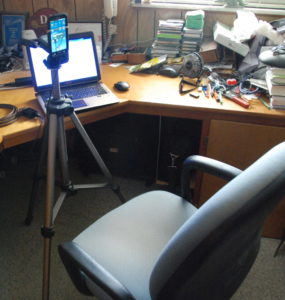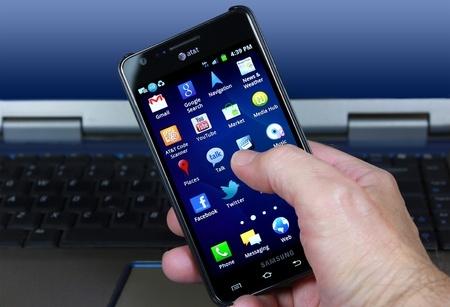Look around your office and tell me how many people are using video conferencing on their smartphone. How about in the park or at the coffee shop down the street? I'd guess not that many. You'd have thought that by now -- with all the hype from Skype, Google,
Apple and
Samsung about multi-mega pixel back and front cameras on smart phones -- that we'd have abandoned the old “cell-phone to the ear” method of talking to someone in favor of much more sophisticated and oh-so-cool video chatting capabilities. So here we are in 2013 and you hardly ever see anybody peering at their smartphone and talking. It's not that the phones aren't smart enough. Dual processors, lots of memory and video chat apps are readily available. Ubiquitous 4G and Wi-Fi make connectivity a non-issue. So what gives? I think there are a few challenges to widespread adoption of the smartphone video conference revolution.
Public Perception
At the mall, you'd think the drama kings and queens – the teenagers -- would be happily smiling into their latest iPhone or Android as they carry on conversations with their friends. But no. Instead they text and talk like they've always done. There might be a bit of a social taboo about video calling, even among the younger crowd. In spite of the nearly constant online presence allowed by Facebook, Twitter and other social media, people just don't seem to want to draw attention to themselves in real life. How many times have you seen someone standing in a parking lot or grocery aisle fully engrossed in a conversation with someone when nobody’s there? Not until you see the tiny Jawbone headset do you realize that they’re on the phone and aren’t a raving lunatic. That kind of thing is worse with video calls. How will the public perception change? I think it's simply a matter of people getting used to using video. But that will take some time. Mobile and software developers have a golden opportunity to draw attention to this cool technology by allowing video calls whenever possible.
Logistics
Load Skype or Google Hangouts on your smartphone and make a few video calls. Casual conversations with a friend or family member are pretty straightforward. You can spin around in your chair or walk around your house while watching your friend's bewildered expression on the other end. However, for anything serious you'll quickly find that the logistics of a video call can be challenging.

The first problem is how to keep the camera steady so your colleagues don't get motion sickness every time you move the phone. The obvious answer is put the phone on some kind of stand. The graphic on the right shows my solution for a recent conference call. A heavy camera tripod is definitely overkill, although the phone was surely stable once I set it up. I had to also fab-up a little L-bracket to hold the phone. It's secured with a rubber band. For a more professional gadget you might look at the
Slingshot smartphone holder and tripod. The
GorillaPod also looks pretty interesting.
Battery Life
Connecting to a video call over 4G will certainly use up your battery pretty quickly. On a full charge my rooted, max-frequency Samsung SIII might give me an hour or so of video calling. Wi-Fi doesn't help the situation much, either. In a pinch, I could always drop the CPU frequency down and turn down the backlight. Still, the most reliable way to go is to call while the phone is plugged into a power source. Lots of places now have USB charging plugs along with their 110 volt outlets. Get a six- or 10- foot cable and you’re in business.
Software
Finally, there's the issue of software. I've used both Skype and Google Hangouts for video conferencing. They both work pretty well, although I find Hangouts to be overly complicated. My last video conference was with three other people. After considerable jockeying around, we finally had connected one person in London (on a PC), one person in San Francisco (on a PC), our tech guy (on a PC) and myself (on my Galaxy SIII). I ran the stock Hangouts application from Google Play. We started our official call and ran through about three-quarters of our meeting when somebody called me on my phone. Panic immediately set in and I hit the “Cancel” button to send the caller to voice mail. I don't know what happened, because from then on I was back on “headset” mode instead of “speaker.” It was nearly impossible to hear the other participants on the call. We were recording the meeting for future use, so I didn't want to risk making adjustments to the phone and dropping the call. The solution was to simply move closer to the phone so I could hear the conversation. Of course, that meant my image was a little distorted due to the built-in, mild fish-eye lens on the camera. The lesson learned was that for any production or office video conference, a user needs to know how to handle phone calls, how to adjust the speaker (or turn it back on) and be able to manipulate other settings. If your company wants to use video calling via smartphone, a little training and a good deal of experimentation is probably in order. That's probably another reason why smartphone video conferencing hasn't taken off.
What's Next?
There are a lot of video capabilities in modern phones. They have fast processors, high quality cameras and considerable bandwidth available via 4G and Wi-Fi. Usable video conference apps can be downloaded with little effort. I just don't think it's hit the mainstream yet. Perhaps I'm not traveling in the right circles. We'll get there, but I think it will take some time. I certainly wish I'd had the technology a dozen years ago, before my mother-in-law passed away, so my kids could have had more face time with her. Mobile developers are on the cutting edge of smartphone technology. I'd love to hear about your everyday successes or ongoing challenges with superphone video conferencing. Post your experiences in the comments below.
 The first problem is how to keep the camera steady so your colleagues don't get motion sickness every time you move the phone. The obvious answer is put the phone on some kind of stand. The graphic on the right shows my solution for a recent conference call. A heavy camera tripod is definitely overkill, although the phone was surely stable once I set it up. I had to also fab-up a little L-bracket to hold the phone. It's secured with a rubber band. For a more professional gadget you might look at the Slingshot smartphone holder and tripod. The GorillaPod also looks pretty interesting.
The first problem is how to keep the camera steady so your colleagues don't get motion sickness every time you move the phone. The obvious answer is put the phone on some kind of stand. The graphic on the right shows my solution for a recent conference call. A heavy camera tripod is definitely overkill, although the phone was surely stable once I set it up. I had to also fab-up a little L-bracket to hold the phone. It's secured with a rubber band. For a more professional gadget you might look at the Slingshot smartphone holder and tripod. The GorillaPod also looks pretty interesting.


